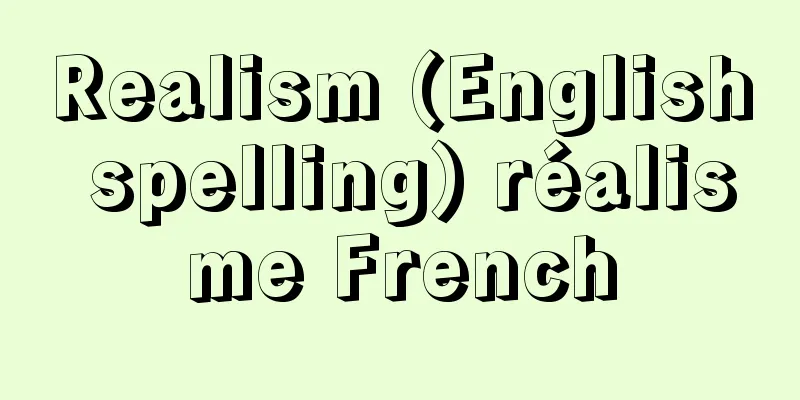Realism (English spelling) réalisme French

|
A term derived from the philosophical term realism, it refers to a literary style or approach that rejects the conceptual and imaginative and aims to portray real facts as they are in an objective manner. The term is used in a broad sense, as in Auerbach's Mimesis (1946), and has been used throughout the ages to refer to all literature with a realistic tendency, but in literary history it specifically refers to a trend that swept across Europe in the 19th century, specifically the mainstream literary trend that blossomed in France in the second half of the 19th century as the most conscious anti-romantic movement and spread throughout Europe. [Naohiro Kato] European expansionThe term realism began to be used in the fields of literature and art in France in the mid-1830s, when the groundwork for modern realism had already been laid by factors such as the reform of the social system, the rise of the bourgeoisie, the advancement of science, and the popularity of positivism. In England, which established a modern civil society earlier than other countries, Richardson, Fielding, and Swift had already produced realistic novels in the 18th century. Diderot and J. J. Rousseau, who were influenced by Richardson's novels in particular, introduced this new style, and on this basis, the two great pioneers of realist novels, Stendhal and Balzac, vividly depicted various aspects of real society with their cold, objective observations and analyses. It was around 1850 that this trend established itself as a school that rejected the ego-praising romanticism that had fallen into excessive emotion, escapism, and grandiose rhetoric, and advocated objectivity rooted in reality. The theory originated in the field of painting, and its first theorist was Courbet, who claimed, "We do not try to see what does not exist, nor distort what does exist with our imagination." Courbet's friend Champfleury applied this viewpoint to literature, and in 1856 launched the group's journal, while Durant, who was also in agreement, founded the magazine Réalisme and, while presenting his own works, launched a movement known as the "struggle for realism" and worked to defend and promote it, leading to Realist literature taking its place as the mainstream of the era. In addition to these two, Murger and Monnier also reproduced the realistic aspects of society and the mundane lives of the people in their novels, but it was Flaubert's Madame Bovary (1857) that achieved great success and sealed the victory of this style, even though he did not belong to the group and denied being a realist himself. From then on, Flaubert came to be regarded as the perfectionist of the realist novel, due to his impersonal and emotionless objectivism, which sought to completely eliminate the author's subjectivity, and his aesthetics, which sought to construct an autonomous world on everyday reality through precise observation and meticulous documentation, that is, on the negation of novelism (Romanesque). Flaubert's scientific objectivism, based on observation and documentation, was eventually inherited by the Goncourt brothers, who sought to write their works as clinical records of society, and the brothers' influence extended to Zola, who believed that "fiction is a science," and realism transformed into naturalism. This trend spread throughout Europe, where it had already begun to take root, but in the 19th century in England, Dickens and Thackeray, who depicted social customs and the lives of ordinary people objectively, as well as George Eliot and the Bronte sisters, showed a tendency towards realism. In Germany, after the early realism of the "Young German" school led by Heine, so-called "poetic realism" blossomed with Keller, Storm, Meyer, Freytag, and Hebbel, and the great writer Fontane of the latter period played the role of a bridge to naturalism. In Russia, Gogol, who succeeded Pushkin, wrote realist novels, and Belinsky established its theory, and from then on it reached its heyday with a unique development. It led to the "naturalists" of Herzen and Turgenev, the great Tolstoy and the psychological realism of Dostoevsky, and Gorky, the founder of socialist realism. In Italy, Romanticism was linked to the Risorgimento (national unification movement), so the flowering of realist literature was delayed, but Verga's writing in a new realist style set in Sicily gave birth to Verismo (a style of verism that includes both realism and naturalism). Other representative writers include Pérez Galdós in Spain, Queiroz in Portugal, and Heijermans in the Netherlands. [Naohiro Kato] Development in JapanIn Japan, modern realist techniques were introduced by Tsubouchi Shoyo and Futabatei Shimei, who studied British and Russian literature, respectively, and Futabatei's Ukigumo (Floating Clouds) (1887-88) became Japan's first fully-fledged realistic novel. However, the early realist theory, which had been relatively legitimately imported, soon merged with the new trend of naturalism that had been introduced from France, and after Tayama Katai's Futon (1907), impersonal literature that should have depicted universal truths transformed into I-novel, which exclusively depicted the individuality of the author (in other words, what is real is not the external reality, but the internal "ego"), leading to the formation of a uniquely Japanese naturalism. [Naohiro Kato] artRealism in art is a method of respecting the appearance of reality or nature and trying to imitate and reproduce it as it is, and the philosophy that supports such an attitude of creation. In a broad sense, it is used almost synonymously with representation as opposed to abstraction. In terms of technique, it refers to the technique of reproducing reality in most paintings and sculptures from Greek art and the Renaissance to the 19th century, known as illusionism. However, even in these cases, it is sometimes in conflict with the methods of stylization, idealization, distortion, and symbolism, and sometimes fused with them, so a strict definition is impossible and it can only be judged in the context in which the term realism is used. In general, it can be classified into two types: a method or attitude of expressing the form, texture, and light and shade of natural space and objects in an illusionistic way, and a tendency to take the customs and objects of everyday reality as the subject matter, especially the life of ordinary people, which naturally accompanies such techniques. The terms realism and realist in the narrow sense are applied to the artistic attitude, technique, and school of painting advocated and practiced by the French painter Courbet, which is a typical example of the latter of the above classifications. In 1855, after being refused permission to exhibit at the Paris Universal Exposition, Courbet held a solo exhibition near the exhibition site, proclaimed himself a "realist," and declared in the pamphlet that he would "portray the customs, ideas, and social conditions of the era to which I belong." Courbet had already learned of realism, a term indicating a new trend among literary figures, from critics around him, such as Castagnari and Champfleury, and named the bar where he and Corot and others gathered the "Hall of Realism," and in 1846 raised the "banner of naming Realist painting for the time being." Courbet's realism was truly realistic in terms of subject matter, theme, and technique, and revealed new claims and techniques against romanticism and classicism. It had a wide influence not only in France but also in other countries, and became a major trend in the 19th century. Socialist realism in the Soviet Union after the revolution and superrealism in modern art can also be seen as different forms of realism. [Kimio Nakayama] "Yamakawa Atsushi, 'Studies on French Realism' (1977, Surugadai Publishing)" Source: Shogakukan Encyclopedia Nipponica About Encyclopedia Nipponica Information | Legend |
|
哲学用語の現実主義(リアリズム)からの転用語で、観念的なもの、想像的なものを嫌い、現実の事実を客観的な態度であるがままに描出しようとする文学上の主張、または様式をいう。この語は、アウエルバハの『ミメーシス』(1946)におけるように広義に用いられ、写実的傾向をもつ文学全般に対し時代を超えて使われもするが、文学史的には、19世紀にヨーロッパを覆った一潮流、厳密には19世紀後半にフランスでもっとも意識的な反ロマン主義運動として開花し全ヨーロッパに広がった文芸主潮を、とくにさしていう。 [加藤尚宏] ヨーロッパでの展開フランスで写実主義の語が文学・美術の領域で使われだしたのは1830年代のなかばごろからで、そのころには、社会制度の変革とブルジョアジーの台頭、科学の進歩と実証主義の流行などの要因によって、近代写実主義の下地はできあがっていた。ひと足早く近代市民社会を打ち立てたイギリスでは、すでに18世紀にリチャードソン、フィールディング、スウィフトらが写実的小説を生み出していたが、そうした、とりわけリチャードソンの小説から影響を受けたディドロ、J・J・ルソーらがこの新しい様式を導入し、その流れのうえにたって、写実主義小説の二大先駆者スタンダールとバルザックが、冷徹客観的な観察と分析で現実社会の諸相を克明に描き出していた。この流れが、情緒過剰、現実逃避、誇大雄弁なレトリックに堕した自我礼賛のロマン主義を否定し、現実に根ざした客観主義を主張する一流派として確立したのは、ほぼ1850年ごろからである。その理論は絵画畑から出たもので、「存在しないものを見ようとしたり、存在するものを想像で歪(ゆが)めたりはしない」と主張するクールベがその最初の理論家となった。 クールベの友人シャンフルリーがこの立場を文学に適用し、1856年、一派の機関誌を発刊、さらに同調するデュランチが雑誌『レアリスム』を主宰、実作を示しながらいわゆる「写実主義闘争」とよばれる運動を展開してその擁護と顕揚に努めた結果、レアリスム文学は時代の主流としての地位を占めるに至った。この2人のほか、ミュルジェールやモニエらがやはり社会の現実的側面や民衆の平俗な生活を小説のなかに再現したが、しかし大成功を収めてこの様式の勝利を決定づけたのは、一派に属さず自らレアリストであることを否定したフロベールの『ボバリー夫人』(1857)である。以後フロベールは、作者の主観を徹底的に排除しようとする没個性と無感動性の客観主義、および精緻(せいち)な観察と綿密な資料とでもって日常的現実のうえに、すなわち小説性(ロマネスク)の否定のうえに自律的な一世界を構築しようとするその美学によって、写実主義小説の完成者と目されることになった。観察と資料を土台にするフロベールの一面の科学者的客観主義は、やがて作品を社会の臨床記録として書き綴(つづ)ろうとするゴンクール兄弟に受け継がれ、兄弟の影響が「小説は科学である」と考えるゾラに及ぶに至って、写実主義は自然主義へと変形していった。 この潮流はすでにその萌芽(ほうが)をみせていたヨーロッパの全土に波及したが、イギリスでは19世紀に入って、社会風俗や庶民生活を客観的に描いたディケンズとサッカレー、さらにジョージ・エリオット、ブロンテ姉妹らが写実主義の傾向を示す。ドイツでは、ハイネをはじめとする「若いドイツ」派の初期写実主義を経、ケラー、シュトルム、マイヤー、フライターク、ヘッベルらによっていわゆる「詩的写実主義」が開花し、最後期の大作家フォンターネが自然主義への掛け橋の役割を果たす。ロシアでは、プーシキンの後を継いだゴーゴリが写実主義小説を、またベリンスキーがその理論を確立し、以後独特の発展をみせながら全盛期を迎える。ゲルツェン、ツルゲーネフらの「自然派」、さらには大トルストイ、またドストエフスキーの心理的リアリズム、そして社会主義リアリズムの創始者ゴーリキーへとつながっていく。イタリアではロマン主義がリソルジメント(国家統一運動)と結び付いていたため写実主義文学の開花が遅れたが、シチリアを舞台にベルガが新しい写実主義手法で書いたことによって、ベリズモ(真実主義――写実主義、自然主義の両方を含む)が誕生した。そのほか、スペインにペレス・ガルドス、ポルトガルにケイロース、オランダにハイエルマンスらの代表的作家がいる。 [加藤尚宏] 日本での展開日本においては、それぞれイギリス、ロシアの文学に学んだ坪内逍遙(しょうよう)および二葉亭四迷(しめい)によって近代写実主義の手法が導入され、二葉亭の『浮雲』(1887~88)はわが国最初の本格的写実小説となった。しかしやがて、比較的正当に移入された初期の写実主義理論は、フランスから入ってきた自然主義の新たな流れに合体し、田山花袋(かたい)の『蒲団(ふとん)』(1907)以後、普遍的真実を描くべき没個性の文学が、作者の個をもっぱら描く対象とする(すなわちリアルなものとは外の現実ではなく、内面の「自我」である)私小説へと変貌(へんぼう)し、日本独特の自然主義を形成するに至った。 [加藤尚宏] 美術美術における写実主義は、現実あるいは自然の外観を尊重し、それをあるがままに模倣、再現しようとする方法、またそのような制作態度を支える思想であり、広義には、抽象に対する具象とほとんど同義語として用いられる。手法的にはギリシア美術や、ルネサンス期から19世紀に至るほとんどの絵画、彫刻における現実再現の手法、いわゆるイリュジョニズムillusionism(錯視的再現の手法)をさす。しかし、これらの場合も、あるときは様式化、理想化、歪曲(わいきょく)、象徴主義の諸方法と対立し、あるときはそれらと融合しているため、厳密な定義は不可能であり、写実主義の用語が用いられるそれぞれの文脈のなかで判断するしかない。一般的には、錯視的に自然の空間や事物の形態や質感、明暗を表現する方法や態度をさす場合と、当然そのような技法を伴うが、日常的現実のなかの風俗や事物を主題とし、とりわけ庶民的な生活にテーマを求める傾向をさす場合とに分類することができよう。 狭義の写実主義、写実派の用語は、フランスのクールベによって提唱され実践された制作態度、手法、その流派に適用されるが、これは、前述の分類の後者の一つの典型である。1855年、パリ万国博覧会に出品を拒否されたクールベは、会場近くで個展を開き、「写実主義者」を標榜(ひょうぼう)し、そのパンフレットで「自己の属する時代の風俗、観念、社会相を描く」と宣明した。すでにクールベは、彼の周辺にあったカスタニャリとかシャンフルリーといった批評家たちから、文学者たちの新しい傾向を示す用語である写実主義を知り、コローたちと集う酒場を「写実主義の殿堂」と名づけ、1846年には「とりあえず写実主義絵画と名づける旗印」を掲げていた。クールベの写実主義は、主題、テーマ、技法の点でまさに写実主義的であり、ロマン主義や古典主義に対する新しい主張と技法を明らかにしたもので、フランスでよりもむしろ他の諸国で広い影響力をもち、19世紀の主要な潮流となった。また革命後のソ連における社会主義リアリズム、現代美術におけるスーパーリアリズムなども、写実主義の別なあり方とみることができるだろう。 [中山公男] 『山川篤著『フランス・レアリスム研究』(1977・駿河台出版社)』 出典 小学館 日本大百科全書(ニッポニカ)日本大百科全書(ニッポニカ)について 情報 | 凡例 |
<<: The Record of Xie's Southern Expedition
Recommend
The Wolf and the Seven Little Goats - Wolf and the Seven Little Goats
(Original title, German: Der Wolf und die sieben j...
Squid Streamer
…The character for kite is a Japanese character. ...
Wakan Sansai Zue (Illustrated Guide to the Three Great Chinese Characters)
An illustrated encyclopedia from the Edo period. ...
John Christopher Pepusch
1667‐1752 German-born opera composer who was activ...
Lèse majesté of places of worship - Lèse majesté of places of worship
The crime of openly committing disrespectful acts ...
Channel catfish
…It resembles the Japanese catfish, but can be di...
Metaphysics
...And under this ontology, physis, which once me...
stereochemical theory
...Although much about its function remains unkno...
mountains
…Mountains are usually grouped together and occup...
Corneal transplantation
The cornea is a transparent tissue about 500 micr...
Mr. Matsuda
A military commander family of medieval Bizen. The...
Unwin, S.
…In 1896, the first international conference of p...
Concentricity
… Saying that point A is on line l is the same as...
geodetic latitude
…coordinates with the origin at the center of the...
Thread Sanada - Thread Sanada
…A bag-shaped braided cord with tassels on both e...









